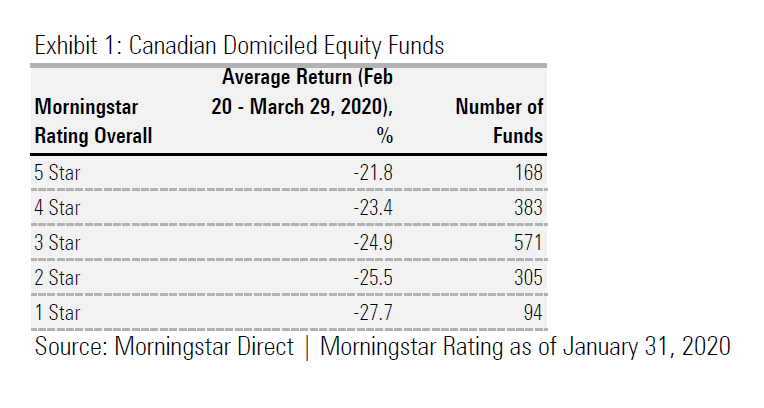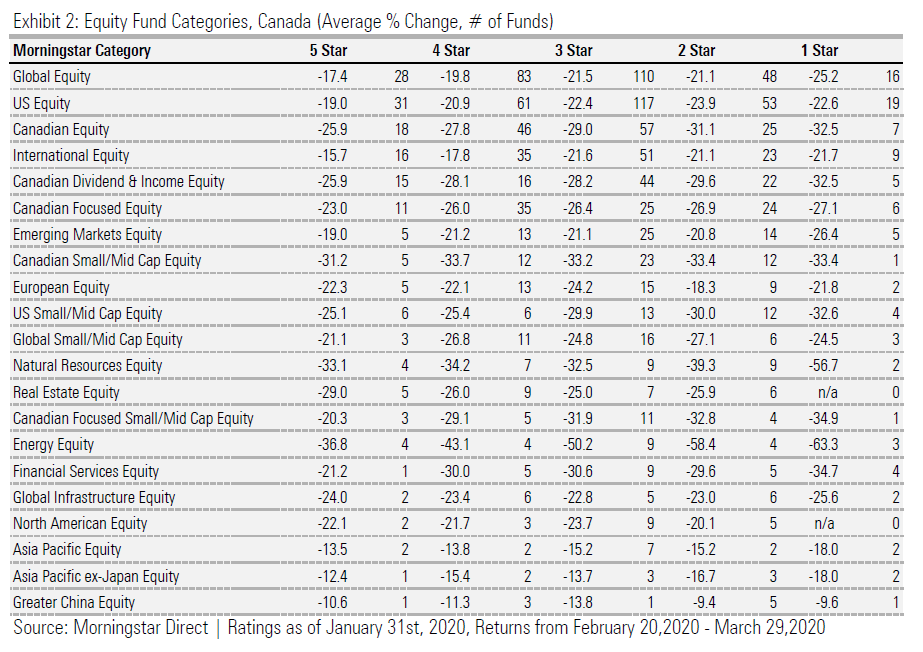
Morningstar’s Star Ratings are a widely recognized framework used to understand the historical risk-adjusted performance of a fund, after fees. By comparing a fund against its own category peers, investors can quickly understand how a fund stacks up. As an investor, it’s vitally important to understand that stars are purely backwards looking and rely solely on a fund’s historical risk-adjusted performance without input from our analysts (for that, seek out Morningstar’s medalist ratings).
All this said, in Canada we’ve found that the star ratings do tend to have some staying power, meaning five-star funds do tend to outperform funds with fewer stars, over the long term. To understand the effectiveness of Morningstar’s Star ratings during the most recent market drawdown, I ran a performance study across the oldest share class of Canadian-domiciled equity funds and ETFs by cross-referencing the star rating as it appeared in our systems at the end of January 2019 to the funds’ gross-of-fees performance during the most recent bout of market turbulence. To get a sense of how the stars performed, I took the average performance of the funds between February 20th (peak of the market) to March 29th, 2020. As a reference point, over this time period, the S&P/TSX Composite fell by 23.9%. At the broadest level (all equity-focused funds) the results looked as follows:

Though not a rosy picture by any stretch of the imagination, the above will give equity fund investors comfort in knowing that the5-star funds seemed to be faring better than their lesser regarded counterparts over the last month, a time that truly tests the resolve of all portfolio managers. This consistent ‘gradient’ of returns is promising and holds up within the more granular Morningstar categories for equity funds in Canada:
In well represented categories like Global, US, and Canadian equities we can see that the gradient of returns has held true during this market drawdown. As you go down the table to look at categories with fewer funds being represented, the performance gradient is less obvious and imperfect (as in you may see two-star funds outperform three-star funds by a marginal amount). In the vast majority of categories, five-star funds outperform one-star funds over this period.
The Takeaway
Morningstar’s star ratings are not meant to be a forward-looking assessment of a fund’s future performance, but they are an excellent starting point for further research. Amidst the market downturn surrounding COVID-19, the star ratings for equity funds are keeping up, despite most funds showing double-digit losses.
Managers who have historically outperformed their peers, seem to be keeping on that trend even during the market debacle unfolding before our eyes. For investors who have additional capital to deploy perhaps through recent contribution to an investment account, or through active re-balancing back to target asset allocations may consider leveraging Morningstar’s star ratings (available here on Morningstar.ca) to look for funds that have continued to outperform their peers.








.jpg)











